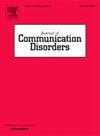Acoustic characteristics of three English semivowels /l, ɹ, w/ and vowels in young children with and without speech sound disorders
IF 2.1
3区 医学
Q2 AUDIOLOGY & SPEECH-LANGUAGE PATHOLOGY
引用次数: 0
Abstract
Purpose
The aim of the current study is to examine if the relationship among three semivowel sounds (/l, ɹ, w/) and between the semivowel and the following vowel differs by children's overall speech proficiency, and if this relationship affects listeners’ perceptual judgment of the liquid sounds (/l, ɹ/). The acoustic proximity among the three semivowel sounds and the acoustic characteristics of the following vowel sounds were examined by each child speaker's overall speech sound proficiency and their semivowel accuracy.
Methods
A total of 21 monolingual English-speaking children with and without speech sound disorders produced monosyllabic words that include target semivowel sounds in word-initial position in different vowel contexts. Participants were divided into three groups based on overall speech proficiency, as measured by diagnostic status and score on the Goldman-Fristoe Test of Articulation – 3rd Edition. Each semivowel and vowel production was transcribed for accuracy, and F2 and F3 values were extracted at the semivowel midpoints to calculate Euclidean distances (ED) between the three semivowel pairs (/l-w/, /l-ɹ/, and /ɹ-w/). F1 and F2 values extracted at the vowel midpoint were used to examine the characteristics of vowels following the semivowels.
Results
Children with typically developing speech with the highest overall speech proficiency demonstrated the largest ED values between all the three semivowel pairs. Larger ED values were also related to a greater likelihood of semivowels /l/ and /ɹ/ being judged as perceptually acceptable. Acoustic characteristics of the following vowels did not differ across children of varying levels of speech proficiency, but did differ by the preceding semivowel context.
Conclusions
Acoustic distinction of semivowels differs across children with varying levels of speech proficiency and is predictive of judgements of semivowel accuracy. Acoustic characteristics of the vowels were influenced by the preceding semivowel target, indicating the presence of coarticulation across the semivowel-vowel sequences. Findings support intervention approaches that pair semivowel targets to train children to produce acoustic differentiation between semivowels.
三个英语半元音/l、r /、w/和元音在有和无语音障碍幼儿中的声学特征
目的:本研究的目的是考察三个半元音(/l, r /, w/)之间以及半元音与后元音之间的关系是否因儿童的整体语言熟练程度而不同,以及这种关系是否影响听者对液体音(/l, r /)的感知判断。通过每个儿童说话者的整体语音熟练程度和他们的半元音准确性来检查三个半元音之间的声学接近度和后面元音的声学特征。方法:对21例有和无语音障碍的单语英语儿童在不同的元音语境中产生包含目标半元音的单音节单词。参与者根据总体语言熟练程度分为三组,通过诊断状态和第三版的戈德曼-弗里斯托发音测试得分来衡量。为了提高准确性,对每个半元音和元音产生进行转录,并在半元音中点提取F2和F3值,计算三个半元音对(/l-w/、/l- r /和/ r -w/)之间的欧几里得距离(ED)。在元音中点提取的F1和F2值用于检测半元音之后的元音特征。结果:语言发育典型的儿童在三个半元音对之间表现出最大的ED值,其整体语言熟练程度最高。更大的ED值也与半元音/l/和/ r /被判断为感知上可接受的可能性更大有关。以下元音的声学特征在不同语言熟练程度的儿童中没有差异,但确实因前面的半元音上下文而有所不同。结论:不同语言熟练程度的儿童对半元音的声学区分是不同的,这是对半元音准确性判断的预测。元音的声学特征受到前面的半元音目标的影响,表明在半元音-元音序列之间存在协同发音。研究结果支持对半元音目标进行干预的方法,以训练儿童产生半元音之间的声学区分。
本文章由计算机程序翻译,如有差异,请以英文原文为准。
求助全文
约1分钟内获得全文
求助全文
来源期刊

Journal of Communication Disorders
AUDIOLOGY & SPEECH-LANGUAGE PATHOLOGY-REHABILITATION
CiteScore
3.30
自引率
5.90%
发文量
71
审稿时长
>12 weeks
期刊介绍:
The Journal of Communication Disorders publishes original articles on topics related to disorders of speech, language and hearing. Authors are encouraged to submit reports of experimental or descriptive investigations (research articles), review articles, tutorials or discussion papers, or letters to the editor ("short communications"). Please note that we do not accept case studies unless they conform to the principles of single-subject experimental design. Special issues are published periodically on timely and clinically relevant topics.
 求助内容:
求助内容: 应助结果提醒方式:
应助结果提醒方式:


